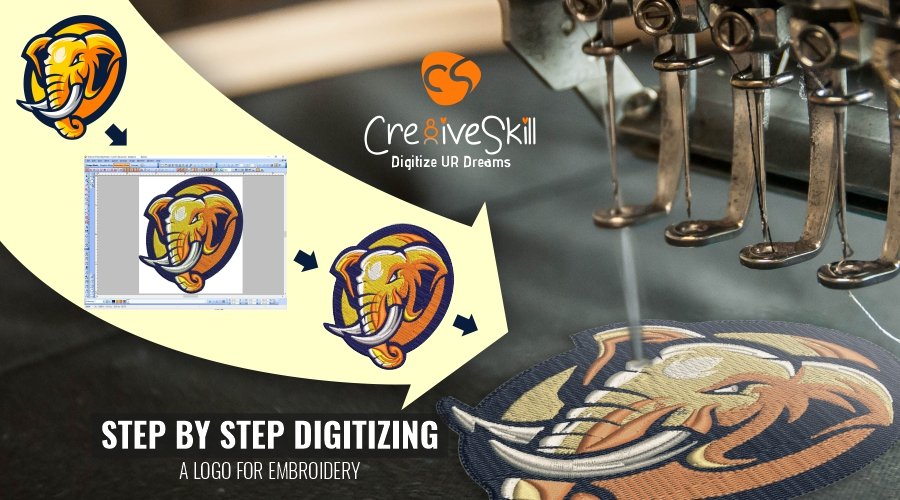Customized Digitizing for Embroidery: Tailored to Your Needs
Wiki Article
Explore Different Kinds Of Embroidery Digitizing Strategies
Needlework digitizing has actually advanced significantly over the years, providing a myriad of techniques to bring styles to life in the digital realm. The world expands to more advanced techniques like photorealistic needlework digitizing and the fascinating world of 3D needlework digitizing.Typical Hand Needlework Digitizing
Typical hand needlework digitizing includes the procedure of transforming complex hand-stitched styles into digital formats for machine needlework. This strategy calls for knowledgeable craftsmens to diligently assess the handmade style and then use specialized software to recreate it in a digital layout. Each stitch, shade, and detail must be carefully converted to make certain that the significance of the original hand needlework is maintained in the digital version.Among the crucial obstacles of typical hand embroidery digitizing is capturing the details and subtleties of the handmade style. Digitizing for Embroidery. Artisans have to have a deep understanding of different needlework methods, such as satin stitch, chain stitch, and French knots, to properly reproduce these methods in the digital world. Additionally, they require to have a keen eye for detail to make sure that the digital layout maintains the very same level of artistry and workmanship as the original hand-stitched item
Punching Technique
To flawlessly shift from typical hand embroidery digitizing to the boxing strategy, craftsmens must currently concentrate on converting the elaborate digital layouts into guidelines that embroidery equipments can analyze. The punching strategy involves making use of specialized software application to develop digital data which contain commands for the embroidery device to follow. This procedure calls for a deep understanding of not just the style itself yet additionally the capabilities and limitations of the embroidery device.
Auto-Digitizing Software Programs
Embroidery digitizing has been transformed by the introduction of auto-digitizing software application programs, supplying craftsmens with innovative devices to transform electronic styles right into embroidery device directions effectively. Auto-digitizing software application use algorithms to analyze digital photos or vector documents and create needlework styles immediately. These programs permit quick and accurate conversion of detailed layouts right into stitch patterns, conserving effort and time for embroiderers.
One of the essential advantages of auto-digitizing software is its user-friendly user interface, making it obtainable to both novices and knowledgeable digitizers. These programs commonly consist of features such as stitch editing devices, thread color matching, and the capacity to sneak peek the final stitched style. Furthermore, auto-digitizing software can manage complicated layouts with numerous colors and intricate information, creating premium embroidery documents appropriate for various apparel and fabric jobs.
While auto-digitizing software supplies benefit and efficiency, it is crucial for individuals to understand the restrictions of automated digitizing. Fine-tuning and manual modifications might still be needed to achieve the preferred embroidery high quality, especially when taking care of intricate or special layouts. By leveraging Get More Info the capabilities of auto-digitizing software program alongside hand-operated digitizing methods, craftsmens can enhance their needlework digitizing procedure and create sensational embroidered pieces.
Photorealistic Needlework Digitizing
Utilizing sophisticated digital imaging techniques, accomplishing photorealistic lead to embroidery digitizing has actually come to be a popular ability amongst modern artisans. This strategy involves transforming high-resolution photos right into elaborate stitch patterns that carefully resemble the original design, leading to needlework items that exhibit lifelike detail and deepness.To achieve photorealistic embroidery digitizing, artisans have to have a keen eye for detail and a thorough understanding of how different stitch types and thickness can impact the last end result. By carefully mapping out each color and shade in the image, embroiderers can create a digital data that guides the embroidery maker to reproduce the subtleties of the initial image properly.
Photorealistic needlework digitizing is especially prominent in developing custom styles for clothing, home style, and art pieces where review capturing the significance of a photo or art work is essential. This method allows craftsmens to change memories, landscapes, portraits, and complex artwork into stunning stitched work of arts that display a blend of traditional craftsmanship and advanced modern technology.
3D Embroidery Digitizing
With the development of digital imaging techniques in achieving photorealistic lead to embroidery digitizing, the exploration of 'D Needlework Digitizing' provides a new measurement to the complexities of style replication. 'D Needlework Digitizing' describes the three-dimensional digitizing strategy that includes depth and appearance to needlework styles, producing a more practical and aesthetically attractive end product. This strategy utilizes software application that simulates the effect of Discover More Here light and shadow on the needlework style, improving its overall aesthetic impact.Among the essential benefits of 'D Needlework Digitizing' is its ability to make layouts look even more realistic and dynamic. By including depth to the needlework design, the end product shows up much more practical and fascinating (Digitizing for Embroidery). Additionally, this strategy permits more innovative flexibility in design execution, allowing embroiderers to experiment with different structures and results that were previously testing to achieve
Verdict

Report this wiki page